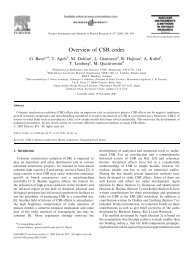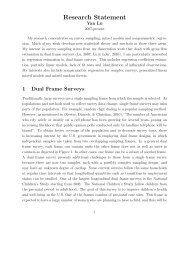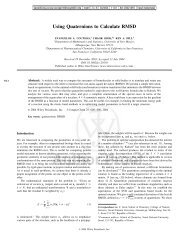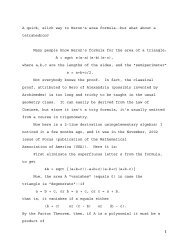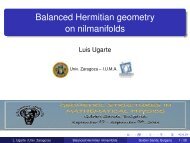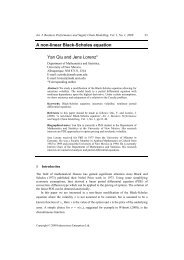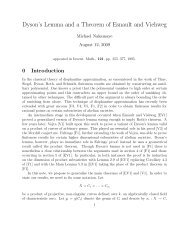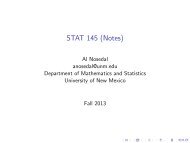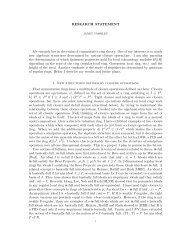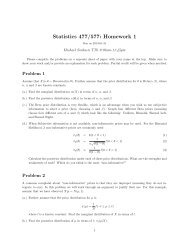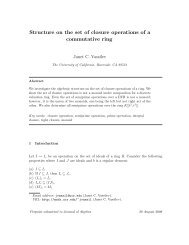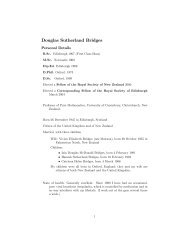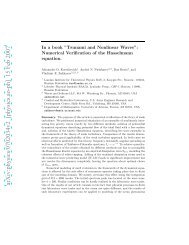OEO Office of Equal Opportunity - Department of Mathematics and ...
OEO Office of Equal Opportunity - Department of Mathematics and ...
OEO Office of Equal Opportunity - Department of Mathematics and ...
You also want an ePaper? Increase the reach of your titles
YUMPU automatically turns print PDFs into web optimized ePapers that Google loves.
210 ARTS AND SCIENCES<br />
**360. L<strong>and</strong> <strong>and</strong> Resource Management. [Political<br />
Geography.] (3)<br />
Spatial organization <strong>of</strong> political processes. Exercise <strong>of</strong> legal<br />
<strong>and</strong> political power over l<strong>and</strong> <strong>and</strong> other resources. Resolution<br />
<strong>of</strong> conflicts between competing government units.<br />
363. Resource Geography. (3)<br />
A systematic analysis <strong>of</strong> spatial economic patterns.<br />
Introduction to models <strong>of</strong> economic space <strong>and</strong> theories <strong>of</strong><br />
spatial economic interaction. Analysis <strong>of</strong> effects <strong>of</strong> resource<br />
attributes <strong>and</strong> distributions upon economic activities.<br />
Examination <strong>of</strong> cultural-economic regions.<br />
**367. Urban Socioeconomic Issues. (3)<br />
An analysis <strong>of</strong> internal forces which influence the morphology<br />
<strong>of</strong> the city. Review <strong>of</strong> internal <strong>and</strong> regional urban location<br />
models with applications to cities in New Mexico. Elements<br />
<strong>of</strong> urban <strong>and</strong> regional l<strong>and</strong> use mapping are studied through<br />
student field projects.<br />
**381L. Introduction to Geographic Information<br />
Systems. (4)<br />
The study <strong>of</strong> spatial data, spatial processes <strong>and</strong> an introduction<br />
to the computer tools necessary to analyze spatial representations<br />
<strong>of</strong> the real world. Exercises in data acquisition,<br />
preprocessing, map analysis <strong>and</strong> map output. Fees required.<br />
Three hrs. lecture, 2 hrs. lab.<br />
**383. Spatial Analysis. (3)<br />
Survey <strong>and</strong> application <strong>of</strong> common quantitative spatial analysis<br />
methods used for analyzing data within a spatial context,<br />
including spatial autocorrelation estimators, point pattern<br />
analysis, analysis <strong>of</strong> line data, <strong>and</strong> an introduction to geostatistics.<br />
Prerequisite: STAT 145.<br />
386. Earth Observing Systems. (3)<br />
A survey <strong>of</strong> satellite <strong>and</strong> aerial platforms <strong>and</strong> sensors.<br />
Emphasis is placed on design specifications, trade-<strong>of</strong>fs in<br />
specifications to optimize system performance, techniques<br />
for radiometric <strong>and</strong> geometric callibration, callibration test<br />
sites, <strong>and</strong> data fusion <strong>and</strong> assimiliation.<br />
*402. Geographic Education. (3)<br />
St<strong>and</strong>ard based geographic methods <strong>and</strong> concepts for social<br />
studies teaching. Presenting geographic techniques <strong>and</strong><br />
materials in the classroom. Map use <strong>and</strong> field projects.<br />
459./559. Natural Resources <strong>and</strong> GIS. (3)<br />
Examination <strong>of</strong> advanced GIS concepts <strong>and</strong> application to<br />
natural resource assessment <strong>and</strong> problem identification.<br />
Synthesis <strong>of</strong> spatial data <strong>and</strong> analysis <strong>of</strong> spatial characteristics<br />
for natural resources.<br />
Prerequisites: 381L.<br />
461./561. Environmental Management. [Environmental<br />
Conservation.] (3)<br />
Examination <strong>of</strong> critical issues <strong>of</strong> environmental degradation in<br />
global <strong>and</strong> local system related to: air <strong>and</strong> water pollution, soil<br />
erosion, deforestation, strip mining, over dependence on fossil<br />
fuels <strong>and</strong> improper management <strong>of</strong> toxic <strong>and</strong> other wastes.<br />
Appraisal <strong>of</strong> the conservation methods <strong>and</strong> policies applied to<br />
these issues <strong>and</strong> the outlook for the future.<br />
Prerequisite: 102.<br />
462./562. Water Resources Management. (3)<br />
An examination <strong>of</strong> the problems <strong>and</strong> trends in the use <strong>of</strong><br />
water resources in the United States, with emphasis on the<br />
physical <strong>and</strong> social aspects related to its management.<br />
Prerequisite: 101 or 102.<br />
463./563. Public L<strong>and</strong> Management. [Public L<strong>and</strong>s <strong>and</strong><br />
Other Shared Resources.] (3)<br />
Defining public <strong>and</strong> private rights associated with managing<br />
natural resources is the key to many <strong>of</strong> the current controversies<br />
concerning the environment. This course looks at public<br />
l<strong>and</strong> policy <strong>and</strong> policy related to other common property<br />
resources such as water, the oceans, <strong>and</strong> the coastal zone.<br />
465./565. Urban Environmental Management. (3)<br />
Williams<br />
History <strong>of</strong> urban attempts to manage the natural environment,<br />
both globally <strong>and</strong> locally. A review <strong>of</strong> ecological <strong>and</strong> natural<br />
constraints <strong>and</strong> feedbacks initiated by urbanization. Field<br />
classes <strong>and</strong> projects.<br />
470. Concepts <strong>of</strong> Applied Geography. (1)<br />
Background readings <strong>and</strong> discussions centered on<br />
Geography as a discipline. Concepts, methods <strong>and</strong> techniques<br />
<strong>of</strong> geographic analysis <strong>and</strong> modeling are applied to a<br />
specific geographic problem. This course is required before<br />
taking 471.<br />
471. Applied Geography Seminar. (3)<br />
Applications <strong>of</strong> environmental analysis <strong>and</strong> geographic information<br />
technologies to a selected geographic problem. Field<br />
trips required. Recommended during the last semester for<br />
majors.<br />
Prerequisite: 470.<br />
483L./583L. Digital Image Processing. (3)<br />
Techniques for extracting information from Earth observing<br />
sensor data. Instruction includes steps <strong>of</strong> image processing<br />
from rectification <strong>and</strong> enhancement <strong>of</strong> digital aerial <strong>and</strong> satellite<br />
data, classification strategies, <strong>and</strong> merging <strong>of</strong> data with<br />
other map products.<br />
Prerequisite: 281L. Two hrs lab.<br />
484./584. Applied Remote Sensing. (3) Morain<br />
Applications <strong>of</strong> aerial <strong>and</strong> satellite sensors for natural<br />
resources. Emphasis is on reviewing <strong>and</strong> evaluating remote<br />
sensing applications in the scientific literature. Further<br />
emphasis is placed on applications <strong>of</strong> remotely sensed data<br />
with geo info systems.<br />
Prerequisite: 386.<br />
487L./587L. Intermediate Geographic Information<br />
Systems. (3)<br />
Examination <strong>of</strong> data structures in GIS. Database management.<br />
Approaches to spatial analysis <strong>and</strong> geostatistical<br />
analysis.<br />
Prerequisite: 381L. Two hrs. lab.<br />
488L./588L. Advanced Geographic Information<br />
Systems. (3)<br />
Customization <strong>of</strong> GIS through use <strong>of</strong> object-oriented programming<br />
language. Project management in the programming<br />
environment.<br />
Prerequisite: 487L. Two hrs. lab.<br />
491./591.–492./592. Problems. (1-3, 1-3 to a maximum<br />
<strong>of</strong> 6) [1 to a maximum <strong>of</strong> 3, 1 to a maximum <strong>of</strong> 3] ∆<br />
Supervised individual study <strong>and</strong> field work. Must be taken for<br />
6 credit hours in the Honors program.<br />
493./593.–494./594. Internship in Applied Geography. (1<br />
to a maximum <strong>of</strong> 3, 1 to a maximum <strong>of</strong> 3) ∆<br />
Written field analysis <strong>of</strong> a project coordinated between student,<br />
faculty <strong>and</strong> public or private manager. Credits to be<br />
determined by supervising faculty.<br />
*499. Topics in Geography. (1-3 to a maximum <strong>of</strong> 6) ∆<br />
Specific topics in geography which relate contemporary<br />
issues to the discipline. Topics will be noted in the appropriate<br />
schedule <strong>of</strong> classes. Credit can be applied by majors to the<br />
appropriate department group requirements for the degree.<br />
501. Research Methods Seminar. (3)<br />
504. Environmental Issues Seminar. (3)<br />
512. Seminar in Physical Geography. (3 to a maximum<br />
<strong>of</strong> 6) ∆<br />
Variable focus depending on the instructor. Typical foci<br />
include biogeography, water resources <strong>and</strong> elements <strong>of</strong> Earth<br />
systems science. Emphasis is on major research questions,<br />
recent advances in the field, <strong>and</strong> on recent literature related<br />
to the causal mechanisms.<br />
Prerequisites: 351 or 356.<br />
UNM CATALOG 2006–2007 Symbols, page 611.



